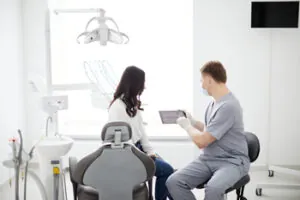In today’s digital age, the omnipresence of search engines like Google has redefined marketing strategies for businesses worldwide. The dental industry, too, feels the winds of this change. You’ve probably heard the term ‘SEO’ thrown around.
But have you considered the paramount importance of SEO content writing for your dental website? In this comprehensive guide, we’ll dissect the world of SEO content writing and unearth the secrets that make dental websites stand out in search engine results.
Understanding the Basics: What is SEO Content Writing?
SEO, or Search Engine Optimisation, is the process of tailoring your web content to be easily discoverable by search engines. When done right, SEO writing enhances your dental website’s visibility, drawing in more organic traffic and, ultimately, potential patients.
The Anatomy of SEO-friendly Dental Content
- Keyword Research: Just as dental treatments begin with a diagnosis, SEO starts with keyword research. Utilise tools to identify relevant keywords. For a dental website, terms like ‘dental crowns’ or ‘teeth whitening’ might be your primary targets. However, delving into long-tail keywords like ‘pediatric dentist in Sydney’ can unearth gold mines of less competitive, highly targeted search intents.
- Titles and Meta Descriptions: The title is your first impression. Ensure it’s compelling, relevant, and integrates with your target keyword. The meta description, that snippet appearing below your title in search results, should encapsulate the essence of your web page while being catchy.
- Relevance and Quality: Ensure the content addresses the user’s search intent. High-quality content that genuinely helps readers will always rank higher. For instance, a detailed blog post on ‘The Benefits of Dental Implants’ could answer common patient queries.
- Natural Keyword Integration: Gone are the days of keyword stuffing. Modern search engines penalise inauthentic content. Sprinkle-related keywords organically throughout your text. Your primary keyword might be ‘dental braces’, but related keywords could include ‘orthodontic treatments’ or ‘braces care’.
- Internal Links: These act as pathways helping search engines understand your site’s structure. For a dental website, linking a blog discussing dental veneers to a service page detailing the procedure is smart.
SEO Content Writing Tips for Dental Websites
- Understand Your Target Audience: Are they parents looking for a child-friendly dentist? Or adults seeking cosmetic dentistry? Tailor your content accordingly.
- Stay Updated with Search Engine Algorithms: Search engines frequently update their ranking algorithms. A strategy that works today might be obsolete tomorrow.
- Diversify Your Content: From in-depth articles about dental procedures to patient testimonials or FAQs, diversify the content to cater to various relevant search queries.
- Avoid Jargon: Remember, most readers aren’t dental professionals. Translate dental jargon into easily digestible information.
- Optimise Images: Every image should have an ALT text. It helps search engines decipher the content of the image. For a dental website, an image of a teeth-whitening procedure might have the ALT text: “Professional teeth whitening results”.
- Stay Consistent: Regularly update your dental blog. Consistency shows search engines that your site is active and offers fresh content.
Great SEO content is not just about the words on the page but also about how users interact with it.
- Readable Layouts: Ensure your content is broken down into easily digestible sections with clear headers. Utilise bullet points, numbered lists, and infographics when appropriate.
- Optimised Page Speed: A well-written piece loses its value if the page takes too long to load. Compress images, leverage browser caching, and optimise CSS delivery to improve load times.
- Mobile Optimisation: Ensure your content layout is responsive. With significant users accessing content through mobile devices, your website and its content should adapt seamlessly.
- Interactive Elements: Quizzes, polls, or interactive infographics can make your content more engaging, increasing the time users spend on your site—a positive signal for search engines.
Harnessing the Power of Social Media in SEO Content Writing
- Shareability: When creating content, always consider its shareability on social media platforms. Engaging content that resonates often gets shared, amplifying its reach.
- Social Signals: While the direct correlation between social signals (likes, shares) and search engine rankings remains a debated topic, there’s no denying that positive social engagement drives traffic and enhances brand visibility.
- Content Amplification: Promote your content through targeted ads on platforms like Facebook or Instagram. Given the visual nature of dental treatments, visually-driven platforms can offer a higher ROI.
Emerging Trends and Keeping Updated
- Voice Search Optimisation: With the proliferation of smart speakers, more users are using voice to search. This requires content to answer questions more conversationally. Phrases like “Which dentist near me offers invisalign?” might become more prevalent.
- AI and Content Creation: While the human touch in content remains irreplaceable, AI tools are emerging to assist content creators. They can offer insights, help with keyword research, or suggest content structures.
- Augmented Reality (AR) in Dentistry: Imagine a future where a user, through AR, can ‘try on’ different dental treatments, be it teeth whitening levels or types of braces. SEO content can delve into these interactive realms, offering users more than just written information.
 The Nuances of SEO Content Writing for Dental Blogs
The Nuances of SEO Content Writing for Dental Blogs
Navigating the digital realm can often feel like setting sail in uncharted waters, especially when it comes to the intricate world of SEO content writing.
The dental sector, while crucial, is a niche in this expansive digital universe.
But, the niche aspect can be leveraged to one’s advantage, especially when armed with the right tools and strategies.
Embracing E-A-T for Dental Websites
E-A-T stands for Expertise, Authoritativeness, and Trustworthiness. Introduced by Google, it plays an instrumental role in site quality ratings.
Expertise: Dental content should provide more than just generic information. It should echo the voice of an expert. A piece on root canal should be more than just a procedural description; it should exude the writer’s or dental clinic’s deep understanding and experience in the field.
Authoritativeness: Establishing authority involves more than just showcasing expertise. If several dentists author or approve the content, or if there are cited research studies and papers relevant to the discussed treatments, it amplifies the authority.
Trustworthiness: Maintaining transparency in content can build trust. For example, discussing both the pros and cons of a dental procedure or even elaborating on the potential risks can make the content seem genuine.
User Intent: The Compass for Content
Understanding user intent is pivotal in crafting SEO-optimised content. There are primarily three types of search intents:
- Informational: The user seeks information, such as “What is teeth whitening?”
- Navigational: The user is seeking a specific site or page, like searching for a particular dental clinic’s website.
Transactional: The user wants to complete an action, like booking an appointment.
By tailoring dental content to cater to these specific intents, one can ensure that their content aligns seamlessly with what users are actively searching for.
Structured Data: Making Content ‘Understandable’ for Search Engines
Structured data can be described as added ‘labels’ to content that aid search engines in understanding its context. For instance, if there’s a blog about “The benefits of dental implants”, structured data can help search engines comprehend that the content pertains to dental health, treatments, and benefits of a particular procedure.
By employing schema markups (a form of structured data), dental websites can enhance their visibility in search engine results through rich snippets, which can include ratings, images, or even FAQs.
The Art of Semantic SEO

- LSI Keywords: Latent Semantic Indexing (LSI) keywords are the phrases related to the main keyword. For dental content, if the primary keyword is “dental crowns”, LSI keywords might include “dental bridges”, “crown materials”, or “tooth restoration.”
- Topic Clusters: These involve crafting a ‘pillar’ content piece, which serves as the main thematic focus, with several subtopics branching out. For example, a dental website can have a pillar content on “Oral Hygiene”, with subtopics like “Flossing Techniques”, “Choosing the Right Toothbrush”, or “Benefits of Mouthwash”.
The Rise of Multimedia in Dental Content
As internet speeds have evolved, so has the nature of online content. Text, while essential, is now one part of a broader multimedia tapestry.
Interactive Graphics: Infographics that allow users to interact, such as zooming, clicking on parts for more information, or even animated segments, can captivate users. Imagine an infographic detailing the anatomy of a tooth, where users can click on parts like enamel, dentin, or pulp for detailed insights.
Podcasts: Audio content is on the rise. Dental clinics can host podcast series discussing various treatments, new advancements in dentistry, or even patient testimonials.
Virtual Reality (VR): While this might sound futuristic, VR in dentistry isn’t that far off. Imagine a patient being able to ‘experience’ a dental procedure in VR before undergoing the actual treatment. SEO content can leverage this, embedding VR experiences within blog posts or pages.
Embracing a Global Audience with Local Sensibilities
Dental websites might cater to a local audience, but the digital realm is global. This brings the challenge and opportunity of crafting content that, while globally understandable, resonates with local sensibilities.
Geo-Targeted Content: If a dental clinic is in Sydney but caters to a significant number of patients from, say, Melbourne, then crafting content targeting both demographics can be beneficial.
Multilingual Content: Even in English-speaking countries, there’s often a diverse demographic. Offering content in multiple languages- Mandarin, Hindi, or Spanish- can set a dental website apart.
Localised SEO Optimisations: There’s general SEO, but there’s also local SEO. Leveraging tools like Google My Business, ensuring that the NAP (Name, Address, Phone number) is consistent across the web, and gathering reviews can bolster a dental website’s local presence.
The Significance of Voice Search in Dental SEO Content Writing
In the age of smart speakers and voice-activated assistants, voice search has surged in popularity. Siri, Alexa, and Google Assistant, among others, are reshaping how users conduct searches online. For dental websites, adapting content to fit this paradigm shift is essential.
Conversational Tone: Voice searches are typically more conversational. For instance, instead of typing “best dental clinic Sydney”, a user might ask, “Where can I find the best dental clinic in Sydney?” Hence, dental content should increasingly mirror this conversational style, answering specific, query-like keywords.
Long-Tail Keywords: Voice searches are generally longer due to their conversational nature. This emphasises the importance of long-tail keywords in dental SEO content writing. An example could be “How long do teeth whitening last?” rather than just “teeth whitening”.
Local Optimisation: A significant chunk of voice searches are local in intent. Phrases like “near me” are common. As such, dental clinics should ensure their content highlights their locality. Incorporating phrases like “Located in the heart of Sydney” can make a difference.
Mobile Optimisation: As many voice searches occur on mobile devices, ensuring that the dental website is mobile-friendly is paramount. Fast loading times, responsive design, and clear navigation can significantly enhance the user experience for voice searchers.
By acknowledging the rise of voice search and adapting content accordingly, dental websites can position themselves at the forefront of this growing trend, ensuring they remain accessible and relevant in this evolving digital landscape.
The Future of SEO Content Writing for Dental Websites
Voice search, AI-driven content recommendations, and augmented reality are just a few advancements shaping the future of online search. For dental clinics, imagining a virtual clinic tour or a voice-activated search for ‘dentists near me’ isn’t too far off.

Dental practices have a unique advantage.
With the right blend of technical SEO and high-quality, patient-focused content, they can connect with their audience meaningfully, answer pressing questions, and position themselves as leaders in the dental domain.
3 Top SEO Content Writing Tips
Meta Description Mastery
The meta description acts as a brief overview of your page’s content, showing up directly under the title in search results. While search engines like Google state it doesn’t directly affect rankings, an engaging meta description can entice users to click on your result over others. When crafting a meta description, ensure it succinctly summarises the page’s content, naturally incorporating target keywords.
Harnessing Internal Links
Internal links not only help in navigating a website smoothly but also distribute page authority throughout the site. Strategically placing internal links within your content can guide readers to other relevant articles or services, enhancing user engagement and reducing bounce rates. Furthermore, these links give search engines a better understanding of your site structure, allowing more of your pages to be indexed.
Choosing the Right Target Keywords
Your content’s effectiveness boils down to the relevance of your chosen target keywords. Instead of blindly following popular trends, focus on keywords that align with your dental website’s offerings and the queries your potential patients might use. Frequently update and refine your keyword list to stay ahead in the constantly evolving SEO landscape.
In Conclusion
In conclusion, while the dazzling world of dentistry focuses on sparkling smiles, the intricacies of SEO content writing ensure those smiles find their way to the right dental chair. As the realm of search evolves, dental industry professionals must harness the power of SEO to stay at the front and centre of patient care and discovery.
Ready to elevate your dental website’s visibility? Mediboost has an arsenal of SEO experts and content maestros to guide you. Contact us on 1300 163 058 today, and let’s create content that not only ranks but resonates.
References
Image Optimization | Learn WordPress
https://learn.wordpress.org/tutorial/image-optimization/
The power of voice search | Business Research and Insights
https://business.nab.com.au/the-power-of-voice-search-34931/
SEO Content Writing 2023 | Data Insight
https://data-insight.org/seo-content-writing-2023/



 The Nuances of SEO Content Writing for Dental Blogs
The Nuances of SEO Content Writing for Dental Blogs
